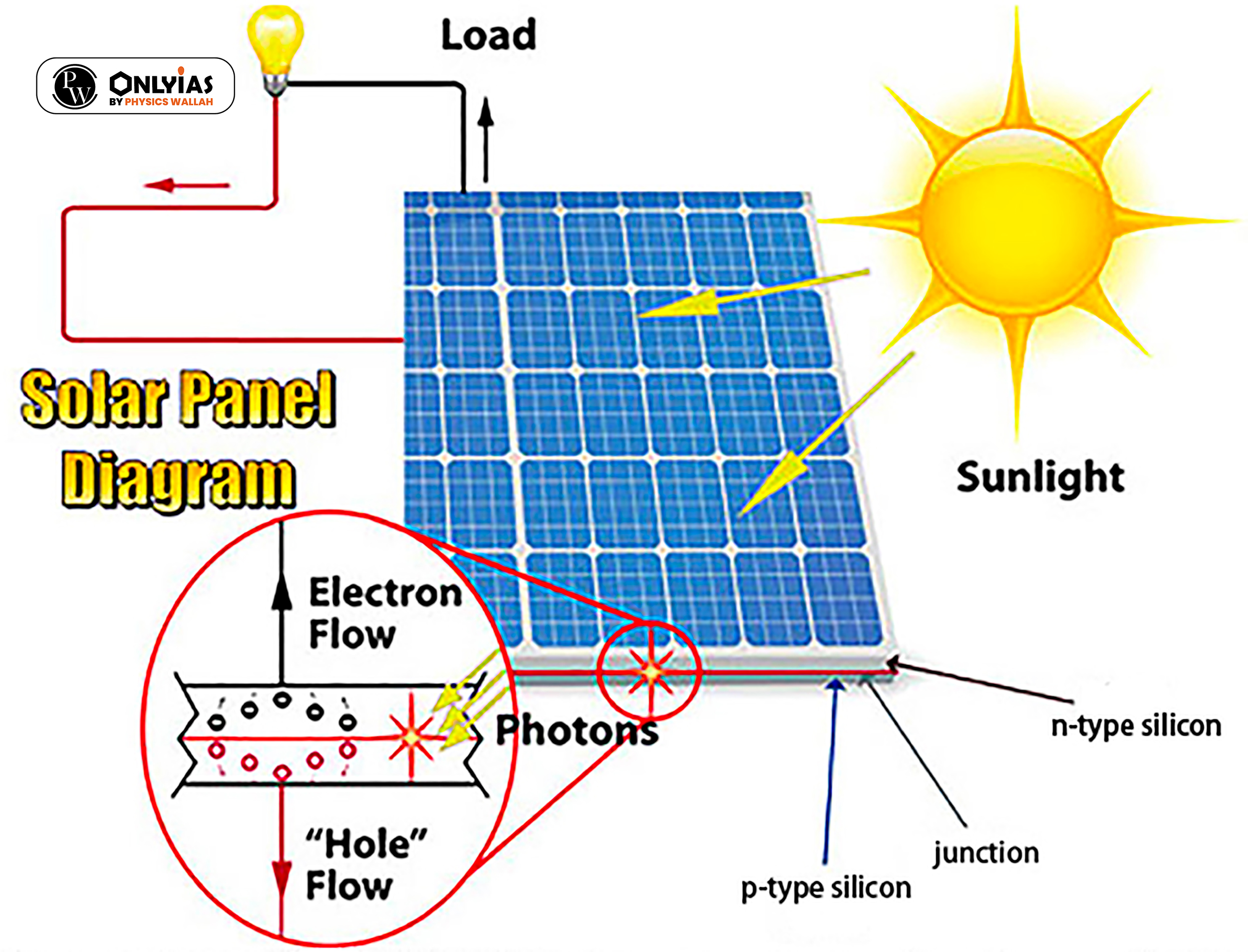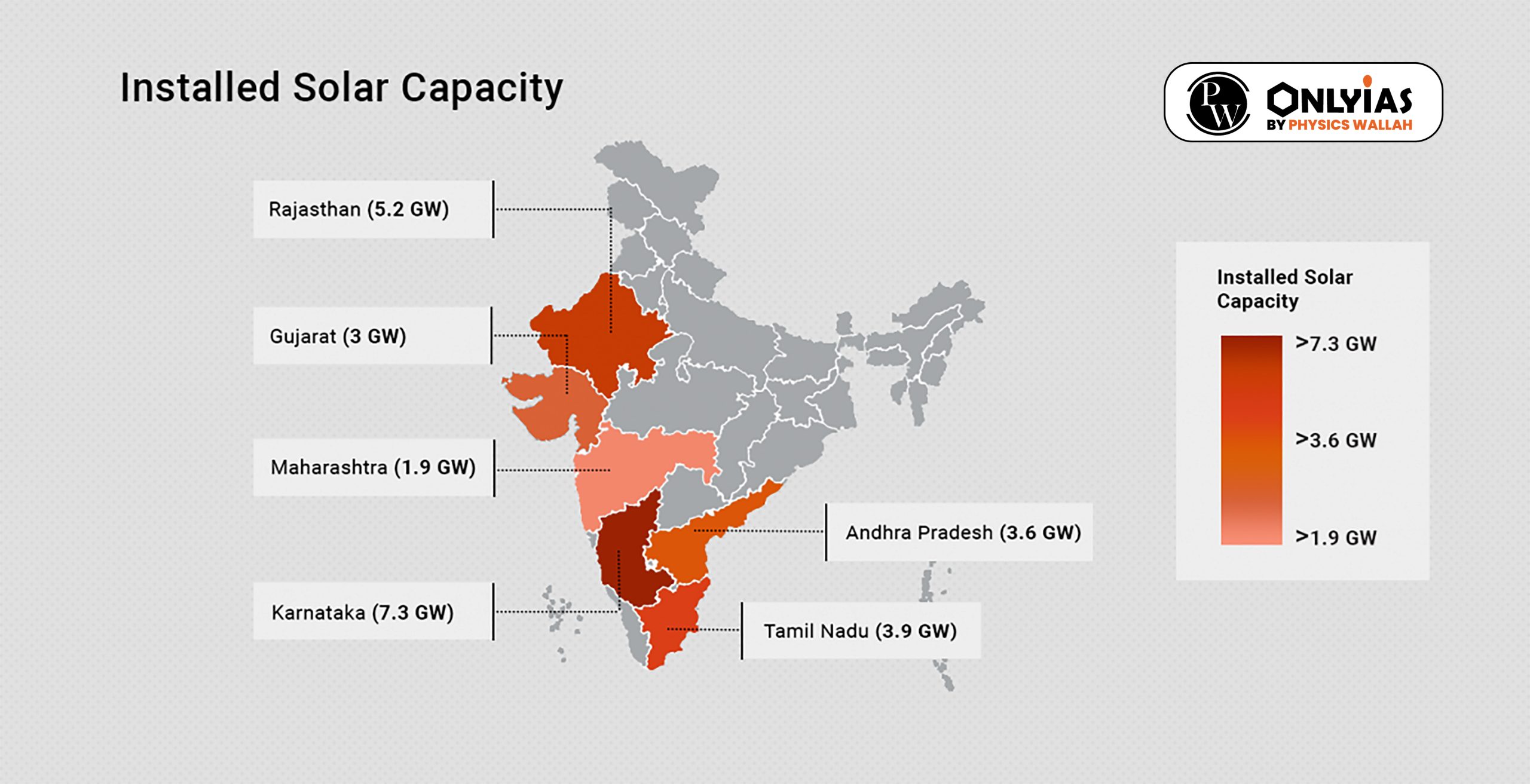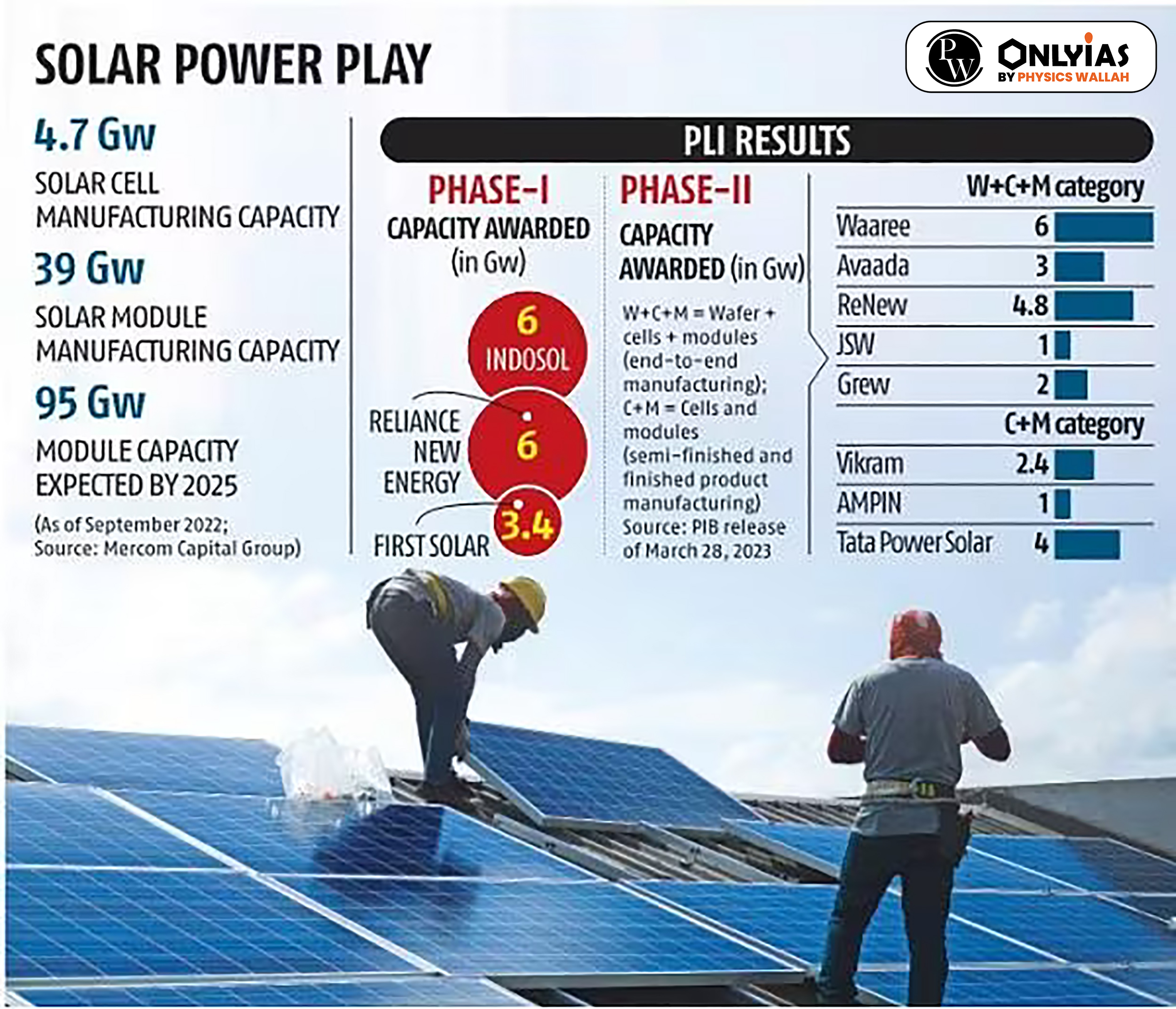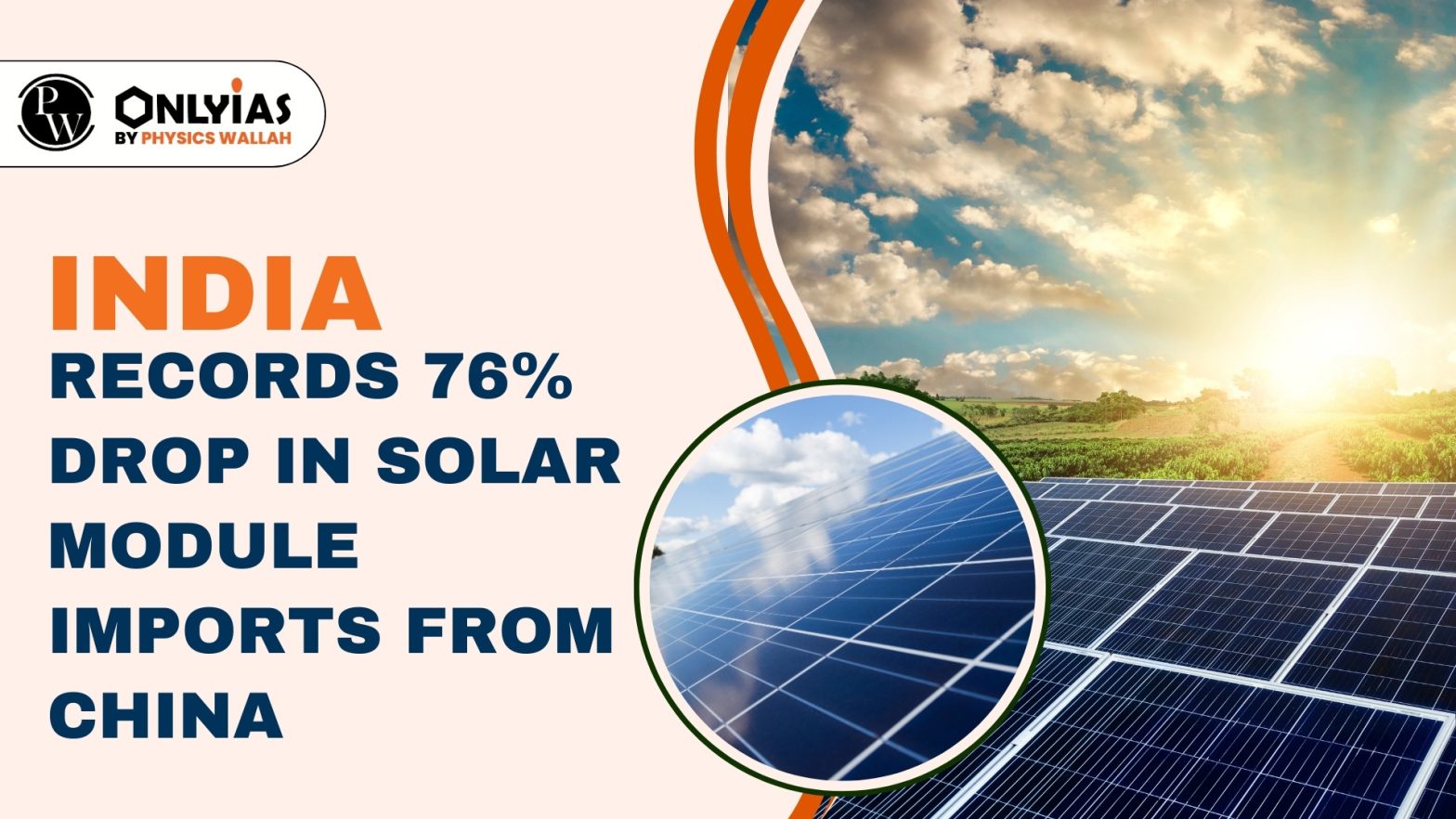Context:
| Relevancy for Prelims: Solar Module, PLI Scheme, International Solar Alliance, PM KUSUM, National Solar Mission, and Atal Jyoti Yojana (AJAY).
Relevancy for Mains: 76% drop in solar module imports from China in the first half of 2023, India’s Solar Power Generation Potential, Challenges in India’s solar module manufacturing, and Government Initiatives. |
India’s Remarkable 76% Decline in Solar Module Imports from China
- As per the report by global energy think tank Ember, Year-on-year, India’s solar module imports from China plummeted from 9.8 GW in the first half of 2022 to a mere 2.3 GW during the corresponding period in 2023.
- This decline is linked to India’s focus on boosting domestic manufacturing, supported by policies like a 40% customs duty on solar module and 25% on solar cells initiated in April 2022.
Solar Energy
- Solar energy is the most abundant of all energy resources and can even be harnessed in cloudy weather.
- Solar technologies convert sunlight into electrical energy either through photovoltaic (PV) panels or through mirrors that concentrate solar radiation (CSP).
- PV cells convert solar radiation (sunlight) into electricity.
- Concentrating Solar Power systems, use concentrated solar radiation as a high temperature energy source to produce electricity.

- This energy can be used to generate electricity or be stored in batteries or thermal storage.
- Global Solar Trends: China remains dominant in the solar module market, exporting 114 GW worldwide, primarily to Europe, Africa, and the Middle East, marking substantial growth.
- China’s dominance in the solar module manufacturing market, accounting for about 80 per cent of the global market share.

Solar Energy Potential in India
- In 2010, India’s solar photovoltaic (PV) capacity was less than 10 MW.
- Over the past decade, India has made significant strides, reaching a PV capacity of over 50 GW by 2022.
- India’s Ambitious Renewable Energy Targets by 2030: India has set an ambitious target of achieving approximately 500 GW of renewable energy deployment by 2030.
- Out of this target, around 280 GW is expected to come from solar PV, making it a dominant contributor to the renewable energy portfolio.This necessitates the deployment of nearly 30 GW of solar capacity every year until 2030.
- India stands 4th globally in Renewable Energy Installed Capacity (including Large Hydro), 4th in Wind Power capacity & 4th in Solar Power capacity (as per REN21 Renewables 2022 Global Status Report).

What are the challenges in India’s solar module manufacturing?
- Dependency on Chinese Solar Module: India heavily relies on Chinese solar module, with about 70% of the country’s solar capacity being built using Chinese-made solar module..
- India has no manufacturing capacity for solar wafers and polysilicon ingots, and currently imports 100% of silicon wafers.
- Competitive Pricing and Scale by China: Chinese manufacturers dominate the global market due to their ability to provide solar module at a competitive price and scale, making it difficult for Indian manufacturers to compete effectively.
- Costs in China are 10% lower than in India, 20% lower than in the United States, and 35% lower than in Europe.
- Policy Instability: The solar module manufacturing industry in India has faced challenges due to inconsistent policies and frequent changes in regulations related to import duties and manufacturing incentives.
- In 2014, following a dumping complaint by Indian solar makers, the ministry of commerce finalised duties to the tune of $0.48-$0.81 per unit on solar cells and modules imported from the US and China. But the Ministry of Finance did not impose them and let the proposed duty lapse.
- Insufficient Market Share for Indian Manufacturers: Despite various initiatives, Indian solar module manufacturers struggle to gain a significant market share, capturing less than 10% of the domestic market. This limits their ability to compete globally.
- Delayed Projects and Cost Overruns: The imposition of import restrictions and changes in policies, such as the Approved List of Module Manufacturers (ALMM), have led to project delays and increased costs for developers, hindering the growth of the solar sector.
- In 2021, the union government announced an Approved List of Module Manufacturers (ALMM) in which all are indigenous players. Project developers were mandated to procure from the list of companies in ALMM.
- Financial Barrier to Solar Module Manufacturing Setup: In India a major financial disadvantage for setting up of industries is the high rate of interest. The cost of debt in India is 11% or highest in the Asia-Pacific region, compared to 5% in China.
- Technology Gap: Indian industry predominantly uses older technologies and smaller wafer sizes compared to the global shift towards newer, more efficient technologies and larger wafer sizes.

What are the initiatives of the Government of India to promote solar energy?
- PM KUSUM:
- Aims to add 30,800 MW of solar and renewable capacity by 2022.
- Central financial support totals Rs. 34,422 Crores.
- Solar Park Scheme:
- Aims to establish multiple 500 MW solar parks across states.
- Atal Jyoti Yojana (AJAY):
- Launched in September 2016 for solar street lighting in states with less than 50% household grid power coverage.
- National Solar Mission:
- A significant initiative promoting sustainable growth and addressing India’s energy security challenge.
- SRISTI Scheme: Sustainable rooftop implementation of Solar transfiguration of India (SRISTI)
- Promotes rooftop solar power projects in India for sustainable energy implementation.
- International Solar Alliance (ISA)
- Objective: To harness solar energy potential across 122 countries within the Tropic of Cancer and Tropic of Capricorn.
- ISA’s vision is to promote solar energy worldwide, envisioning ‘One World, One Sun, One Grid’ (OSOWOG).
- PLI Scheme for Solar Module: The Union Government established Rs 19,500-crore production-linked incentive scheme to boost high-efficiency solar module manufacturing.
- Aims to attract Rs 94,000 crore in investments for the sector.
- The leading players from both private and public sectors are expected to build a manufacturing capacity of 39.6 GW under the PLI scheme.
- The government aims to achieve operational manufacturing capacity of 7.4 GW by October 2024, 16.8 GW by April 2025, and the remaining 15.4 GW by April 2026.
- Participation of Foreign Companies: US-based First Solar has been selected as the only foreign player under the PLI scheme for solar module manufacturing, emphasizing global participation in the initiative.
|
The International Energy Agency (IEA’s) five key policy action areas to ensure solar PV security of supply:
- Diversify manufacturing and raw material supplies
- De-risk investment
- Ensure environmental and social sustainability
- Continue to foster innovation
- Develop and strengthen recycling capabilities
|
Way Forward
- Promoting Domestic Manufacturing: The Indian government’s initiatives like the Production-Linked Incentive (PLI) scheme aim to boost domestic manufacturing of solar module and reduce reliance on imports.
- Investment in Research Facilities: Invest in creating high-quality research and development facilities to support innovation and technology development in the solar sector.
- India has hardly invested in creating high-quality high-TRL technology centres such as IMEC Belgium or the Holst Centre in the Netherlands, which can help the industry to try and test the technologies in a cost-effective manner.
- Recycling of solar PV panels: It offers environmental, social and economic benefits while enhancing security of supply in the long term.
- If panels were systematically collected at the end of their lifetime, supplies from recycling them could meet over 20% of the solar PV industry’s demand for aluminium, copper, glass, silicon and almost 70% for silver between 2040 and 2050 in the IEA’s Roadmap to Net Zero Emissions by 2050.
- Diversifying Supply Chain:
- Work on diversifying the supply chain by exploring alternative sources and fostering collaborations to ensure a consistent and reliable raw material supply.
- Other Government Initiatives:
- Support for Semiconductor Fabrication Plants: 50% fiscal support for setting up semiconductor fabrication plants to address silicon wafer shortages.
- M-SIPS for Manufacturing Facilities: Modified Special Incentive Package Scheme offers a 20-25% subsidy on capital expenditure for setting up manufacturing facilities.
- Local Sourcing Mandate for Solar Producers: Mandate for solar power producers to source a certain percentage of solar modules and cells locally to benefit from government energy purchase guarantee.
Conclusion:
India’s remarkable 76% decline in solar module imports from China in the first half of 2023 reflects a strategic shift towards self-sufficiency, driven by government initiatives like the Production-Linked Incentive (PLI) scheme, signaling a positive trajectory for domestic solar module manufacturing.
| Prelims Question (2020)
With reference to solar water pumps, consider the following statements:
1. Solar power can be used for running surface pumps and not for submersible pumps.
2. Solar power can be used for running centrifugal pumps and not the ones with piston.
Which of the statements given above is/are correct?
(a) 1 only
(b) 2 only
(c) Both 1 and 2
(d) Neither 1 nor 2
Ans: (d) |
| Mains Question: Describe the benefits of deriving electric energy from sunlight in contrast to conventional energy generation. What are the initiatives offered by our government for this purpose? (2020) |
![]() 16 Oct 2023
16 Oct 2023




